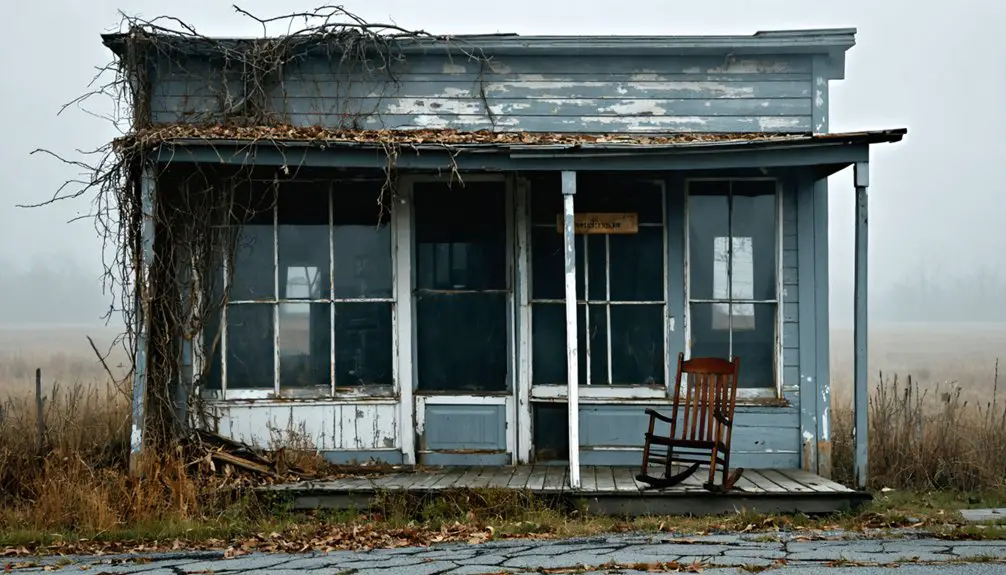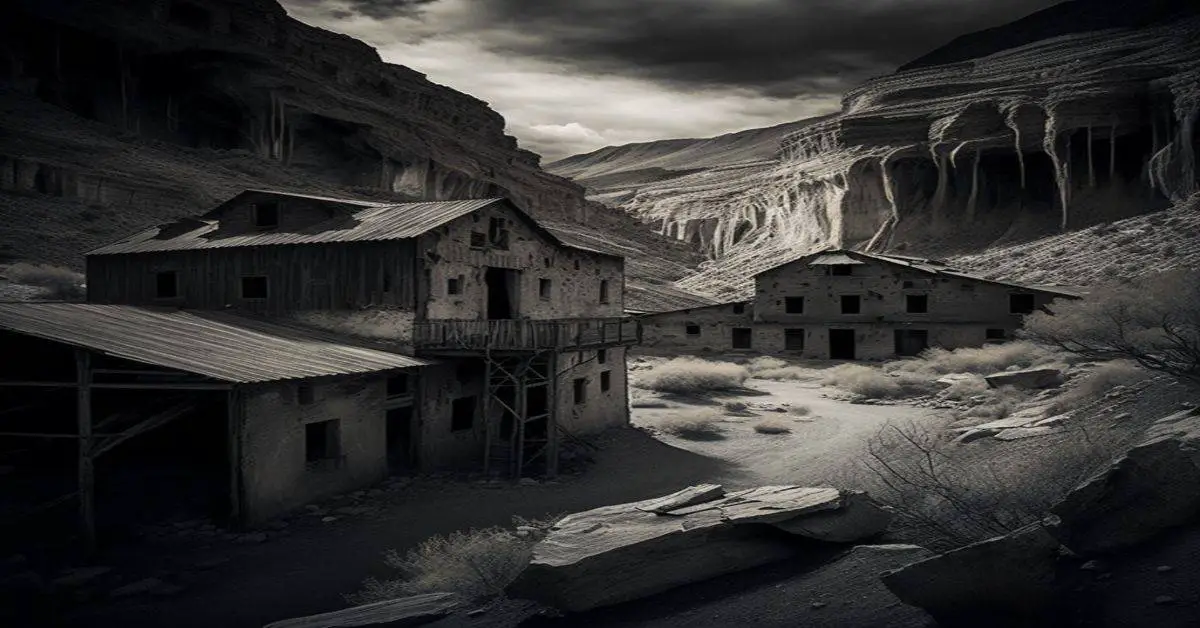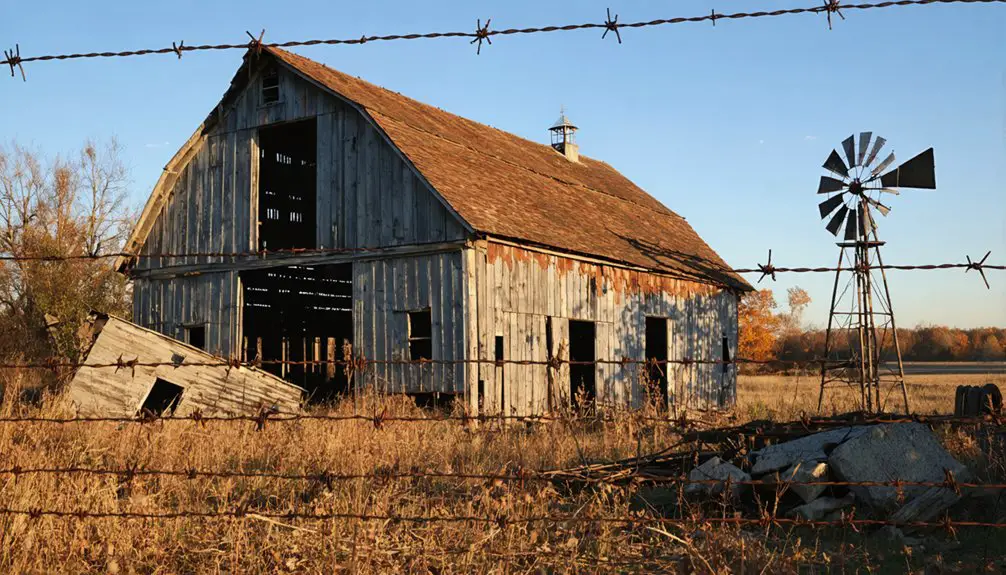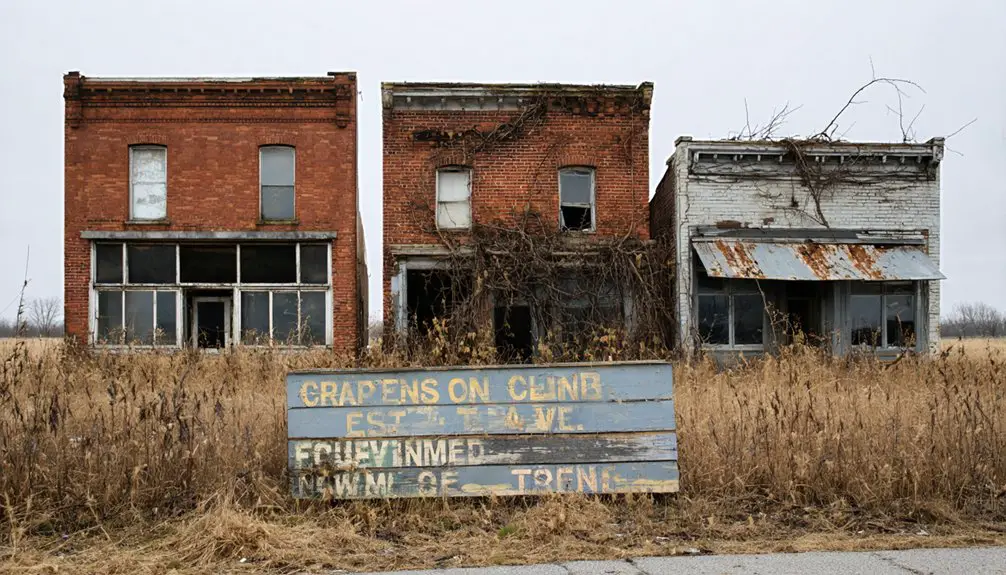You’ll find Wonderland’s abandoned foundations nestled along Ohio’s Big Walnut Creek, where a post-WWI utopian experiment once flourished. This communal settlement thrived until the 1970s when airport expansion forced residents to relocate. Today, only a solitary church remains active among the weathered ruins, while nature reclaims the old streets and homesteads. Beneath the thick vegetation and modern asphalt, traces of this idealistic community’s past beckon curious explorers.
Key Takeaways
- Wonderland was a post-World War I utopian community in Ohio that thrived until the 1970s when airport expansion led to its abandonment.
- Located along Big Walnut Creek, the town experienced regular flooding that challenged its residents throughout its existence.
- Only one church remains active in Wonderland today, while other structures have been reclaimed by nature and vegetation.
- Archaeological evidence reveals prehistoric settlements and burial sites, though flood deposits and contamination complicate modern excavation efforts.
- The ghost town’s legacy lives on through local folklore, including stories of phantom trains and ghostly railroad workers.
The Rise and Fall of a Hidden Community
While many Ohio communities emerged from industrial or agricultural beginnings, Wonderland took shape as a bold social experiment in the aftermath of World War I. Along the banks of Big Walnut Creek, founders established their vision of a perfect society, driven by utopian ideals of shared ownership and communal living.
You’d have found a close-knit community determined to escape the greed and chaos of city life. Annual floods from Big Walnut Creek repeatedly tested the resilience of residents who stayed despite their homes being submerged.
Yet this dream faced significant community challenges from the start. Early settlers grappled with financial difficulties and internal disagreements, causing some to abandon the experiment within its first year.
Financial strain and internal conflicts tested the settlers’ resolve, pushing some to leave their utopian dreams behind.
Despite these hardships, many residents persevered, building a thriving settlement that would endure until the mid-20th century, maintaining their commitment to collective resources and regular community activities. The community’s fate was sealed in the 1970s when residents were bought out for airport expansion.
Mapping Wonderland’s Historical Location
Pinpointing Wonderland’s exact location poses three distinct mapping challenges for modern historians and researchers.
First, you’ll find no precise GPS coordinates in public records, though nearby landmarks like the Benjamin Franklin Highway and Ghost Town Trail offer essential clues.
Second, you’re working with fragmented historical data – old county maps, post office records, and railroad routes that only hint at Wonderland’s position within Ohio’s southwestern countryside.
Third, the landscape has dramatically changed, with former town sites now converted to farmland and rural parcels. The area’s transformation into rolling hills and fertile grounds mirrors the broader geography of Ohio’s horse country.
For ghost town exploration enthusiasts, historical mapping of Wonderland requires piecing together evidence from surrounding features, including Ohio Brush Creek tributaries, cemetery records, and remnants of old transportation corridors that once connected this vanished community to neighboring settlements. The site lies approximately 24 miles northeast of Cincinnati, sharing the same general vicinity as Kings Island amusement park.
Life in Early Settlement Days
Beyond mapping Wonderland’s physical location, you’ll discover a rich tapestry of pioneer life that shaped this Ohio settlement during its earliest days.
The Columbus Metropolitan Library preserves many historical records from this era, documenting the daily lives of these early settlers.
Like many frontier communities, you’d have found a tightly-knit group of settlers, many from New England, working together to forge their own destiny in the Ohio Valley’s fertile grounds. Much like The First 48, these determined settlers faced harsh conditions as they established their new community.
The pioneer lifestyle in Wonderland reflected the determination of early Ohio settlers:
- You’d have witnessed families clearing dense forests and establishing agricultural practices suited to the region’s rich soil.
- Your community would’ve centered around cooperative labor events, with neighbors helping each other build homes and harvest crops.
- You’d have participated in regular gatherings at the settlement’s church and school, which served as anchors of frontier social life.
Railroad Impact and Economic Growth
As the Valley Railway carved its path through Ohio in the late 1860s, Wonderland’s fortunes transformed dramatically.
You’d have witnessed the town’s unprecedented railroad expansion as the Baltimore & Ohio Railroad established essential connections between eastern markets and western territories, threading through Wonderland’s growing industrial landscape.
The railroad’s presence sparked remarkable economic resilience in your community. During the economic downturn of 1837, the town showed resilience as railroad construction slowed across the state.
You could’ve seen local farmers prospering as they gained access to broader markets, while the extraction of minerals, coal, and other natural resources became increasingly viable.
The establishment of repair shops and freight yards created steady employment opportunities, and the constant flow of goods through Wonderland’s rail network cemented its position as a critical link in Ohio’s industrial chain.
The town’s strategic location along major rail routes guaranteed its growth throughout the late 19th century, much like the success seen when the Hocking Valley merged with other rail systems to enhance regional connectivity.
Notable Buildings and Landmarks
Though Wonderland once thrived as a bustling railway town, today you’ll find only scattered remnants of its former glory. A solitary church stands as the last active building, while nature reclaims the remnants of what was once a promising residential development. Similar to Ghost Town of New Hope, the abandoned buildings and eerie atmosphere attract paranormal investigators. Like the Moonville Rail Trail, local preservation groups work to connect these historic sites for visitors.
The town’s exclusive social centers, including the Wonderland Club and Appalachian Club, have been reduced to sturdy foundation stones that hint at their past grandeur.
- You can trace the town’s footprint through surviving chimneys and club foundations that peek through the dense forest growth.
- Several original homes remain standing, though they’re largely abandoned and weathered by time.
- While specific cemetery remnants aren’t documented in Wonderland itself, nearby ghost towns preserve burial grounds that tell stories of similar lost communities.
The Great Columbus Expansion
When Columbus began its dramatic postwar expansion in the 1950s, Wonderland’s fate was already sealed.
Under Mayor Sensenbrenner’s aggressive annexation policies, you’d have witnessed the city swallowing up vast tracts of unincorporated land, forever changing the region’s community dynamics. Columbus wielded its control over water and sewer services like a weapon, forcing surrounding areas into submission or isolation.
The urban development explosion added nearly 10 square miles in 1955 alone, as Columbus methodically absorbed territory in all directions.
You couldn’t stop the city’s relentless growth as it pushed into four counties, encircling established suburbs like Upper Arlington and Bexley. This expansion transformed Columbus into Ohio’s largest city by area, surpassing both Cincinnati and Cleveland while reshaping the destinies of countless small communities like Wonderland.
Remnants and Archaeological Findings
If you explore Wonderland’s grounds today, you’ll find scattered foundation remnants typical of Ohio ghost towns, with stone supports and structural debris partially hidden by decades of natural overgrowth.
Archaeological surveys have revealed evidence of prehistoric village settlements in the surrounding area, including burial sites and earthworks that suggest long-term habitation patterns.
The site’s location within Zone 3 East of Newtown, combined with its proximity to known archaeological complexes like Hahn Village and Madisonville, indicates potential for further significant discoveries through systematic archaeological investigation using modern techniques like LiDAR and magnetic surveys.
Physical Structures Still Standing
Among the scattered remnants of Wonderland, Ohio, a solitary church stands as the last complete structure from this once-thriving community.
While the other historical remnants have succumbed to time and airport expansion, you’ll find only fragments of what once was – crumbling foundations overtaken by nature and weathered building materials scattered throughout the dense vegetation.
If you venture into this abandoned landscape today, you’ll discover:
- The surviving church, still occasionally used by local residents for services
- Deteriorating concrete slabs and stone foundations barely visible through thick overgrowth
- Traces of original streets, including parts of Wonderland Boulevard, hidden beneath layers of modern asphalt and years of natural reclamation
These silent witnesses tell the story of a community that disappeared beneath the march of progress.
Archaeological Evidence Discovery Sites
Through decades of archaeological exploration, Wonderland’s subterranean landscape has revealed a complex network of burial chambers and prehistoric settlements.
You’ll find sophisticated masonry vaults near the old cemetery, each roughly 10 feet square with branching chambers containing bones, chains, and coins.
Archaeological techniques have uncovered several significant village sites in the region, including burial practices tied to the area’s prehistoric mound-building cultures.
While flood deposits have complicated excavation efforts, you can still trace the remains of communal buildings and stone foundations beneath layers of alluvial soil.
However, toxic contamination from the Krejci Dump has restricted modern excavation work, forcing archaeologists to rely on remote sensing and limited invasive testing to preserve these valuable historical sites.
Legends and Local Stories
You’ll hear whispers of ghostly railroad workers along the abandoned tracks, where local residents claim to see phantom lights and hear the echoes of long-gone trains in the night.
The old Wonderland schoolhouse, now reduced to its foundation, draws particular attention from paranormal investigators who’ve documented unexplained voices and shadows moving through the empty space.
These stories, much like the spiritualist séances of the 1840s, have become deeply woven into the area’s folklore, creating a tapestry of supernatural tales that continue to captivate visitors to this day.
Local Railroad Tales
While the Baltimore and Ohio Railroad shaped much of Ohio’s railway development in the late 1800s, the tracks near Wonderland became particularly notorious for their haunting tales and mysterious occurrences.
Like many Ohio railroad towns, you’ll find stories of railroad hauntings that echo the region’s dangerous past, when accidents claimed the lives of workers during the rapid expansion of rail lines.
- Spectral locomotives have been reported gliding silently along abandoned tracks at night, their phantom lights piercing the darkness before vanishing into thin air.
- You might hear tales of a ghostly conductor who still walks the line searching for his lost train after a fatal derailment.
- Local folklore speaks of unexplained whistles and ethereal figures waving from windows of trains that no longer exist, particularly near old Valley Railway routes.
Schoolhouse Ghost Stories
Railroad hauntings aren’t the only supernatural tales that color Wonderland’s ghostly reputation.
You’ll find the old brick one-room schoolhouse, standing silently three-quarters of a mile southeast of SR 117 and Madden Road, at the heart of local paranormal lore. While there aren’t documented ghost sightings specific to this Auglaize Township No. 6 school, its proximity to Ward Cemetery and connection to Wonderland’s spiritualist history fuel countless stories.
Visitors report spectral echoes of children’s voices carrying across the empty grounds, made more haunting by the building’s isolation and deteriorating condition.
The schoolhouse’s transformation from a center of learning to an abandoned shell mirrors Wonderland’s own decline, particularly after the airport expansion displaced the remaining residents and sealed off much of the area.
Preserving Wonderland’s Legacy
Although much of Wonderland’s physical presence has faded into Ohio’s landscape, dedicated efforts to preserve its legacy continue through multiple channels.
Through community engagement and heritage conservation, you’ll find extensive documentation at Columbus Metropolitan Library’s archives, while local historians work tirelessly to maintain the town’s rich history through written records and oral histories.
- The sole remaining church stands as a symbol of Wonderland’s resilience, serving as a focal point for preserving the area’s heritage.
- Historical documentation includes detailed maps, property records, and photographic evidence maintained by exploration groups.
- Legal records from residents’ battles against Columbus airport expansion provide vital insights into the community’s fight for survival.
These preservation efforts guarantee that Wonderland’s story lives on, even as nature reclaims its physical remains.
Frequently Asked Questions
Were Any Famous Historical Figures Known to Have Visited Wonderland?
You won’t find any records of famous visitors or historical events taking place in Wonderland, as no documented evidence exists of prominent figures ever visiting this small utopian community.
What Native American Tribes Originally Inhabited the Wonderland Area?
Like footprints in time’s sand, you’ll find the Shawnee and Erie tribes originally claimed this land as their cultural heritage, with the Erie along Lake Erie’s shores and Shawnee in central Ohio.
How Did the Town Get Its Unusual Name “Wonderland”?
You’ll find the name origin stems from early settlers’ utopian vision of creating an idyllic retreat. They chose “Wonderland” to reflect their whimsical history of establishing a perfect community outside Columbus.
What Was the Highest Recorded Population of Wonderland?
You’ll find no official census records showing the exact peak population of this ghost town, though historical estimates suggest it never exceeded a few hundred residents before its gradual population decline.
Did Any Significant Natural Disasters Affect Wonderland’s Development?
You won’t find records of major earthquakes affecting the area, though the town did face regular flood impacts from Big Walnut Creek and Ohio River – nothing catastrophic enough to determine its fate.
References
- https://www.youtube.com/watch?v=QWTtG6njIDs
- https://kids.kiddle.co/List_of_ghost_towns_in_Ohio
- https://ohioghosttowns.org/county-data-charts/
- https://ohioghosttowns.org/franklin-county/
- https://www.tiktok.com/@columbuslibrary/video/7226722949846404395?lang=en
- https://www.youtube.com/watch?v=2UoRR7HrYFw
- https://www.youtube.com/watch?v=Jabw-3XdHbk
- https://en.wikipedia.org/wiki/List_of_ghost_towns_in_Franklin_County
- https://www.mossyoakproperties.com/land-for-sale/ohio/horse/?pg=10
- https://www.hipcamp.com/en-US/d/united-states/pennsylvania/lake-latonka/camping/shower



